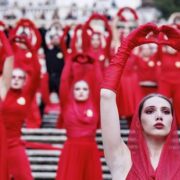Two artists, one home
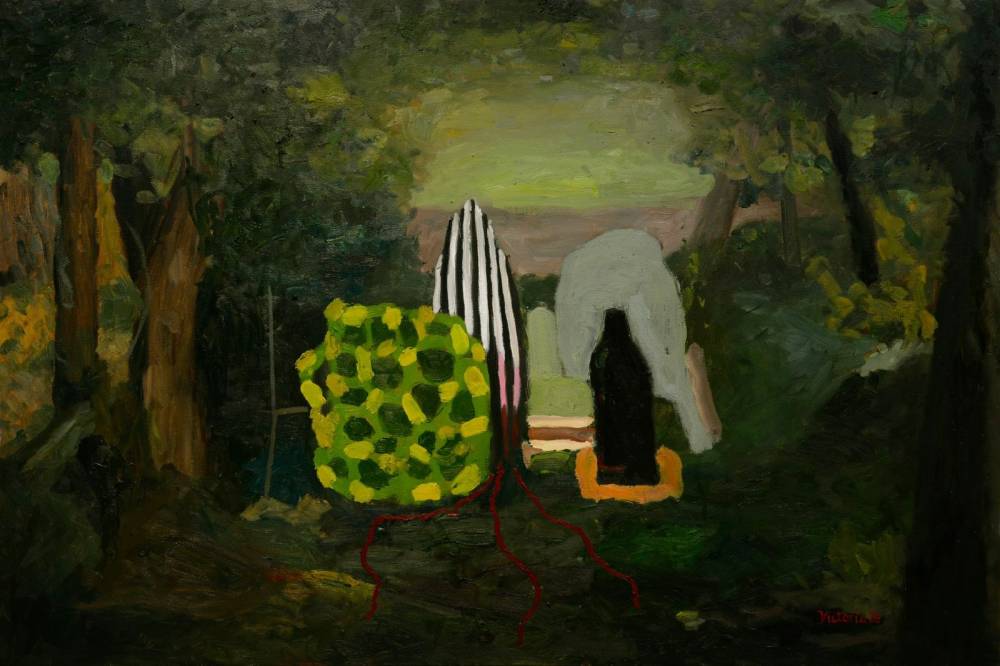
He builds mythologies of faith and transformation; she paints the poetry of motherhood. While Jason and Victoria Montinola work in different registers, this pair of husband-and-wife artists shows how art has become a shared language in the family.
Having practiced art in the Philippines for nearly two decades, Jason has steadily been building worlds, creating an imagined universe through his figures, using age-old oil painting techniques that reference the Middle Ages, the Renaissance periods, and even before the 5th century—but all with supernatural twists. Many hold symbolic meaning, often with biblical echoes (though with such strange anatomies piercing through their skins, you would never think it).
Victoria started painting later, after her marriage to Jason. With the guidance of her husband, she discovered she had a natural talent for art making. Participating in her first exhibition in 2018, she has steadily begun to exhibit abroad, making her way into embassies, high offices, and other notable collections. Her works often depict paintings filled with trees, gentle brooks, and softly glowing sunsets, but layered with abstraction like unexpected configurations of geometric lines and billowing shapes.
It makes you wonder, could Jason’s characters and Victoria’s landscapes coexist together? Maybe one lives in the other? Regardless, both of the artists’ works can now be viewed together at West Gallery in Quezon City. Jason’s “Temporal” and Victoria’s “Home” are both running simultaneously till Dec. 6 this year. With both their practices exhibited side by side, viewers can immerse themselves in the respective artists’ fascinating dual worlds.
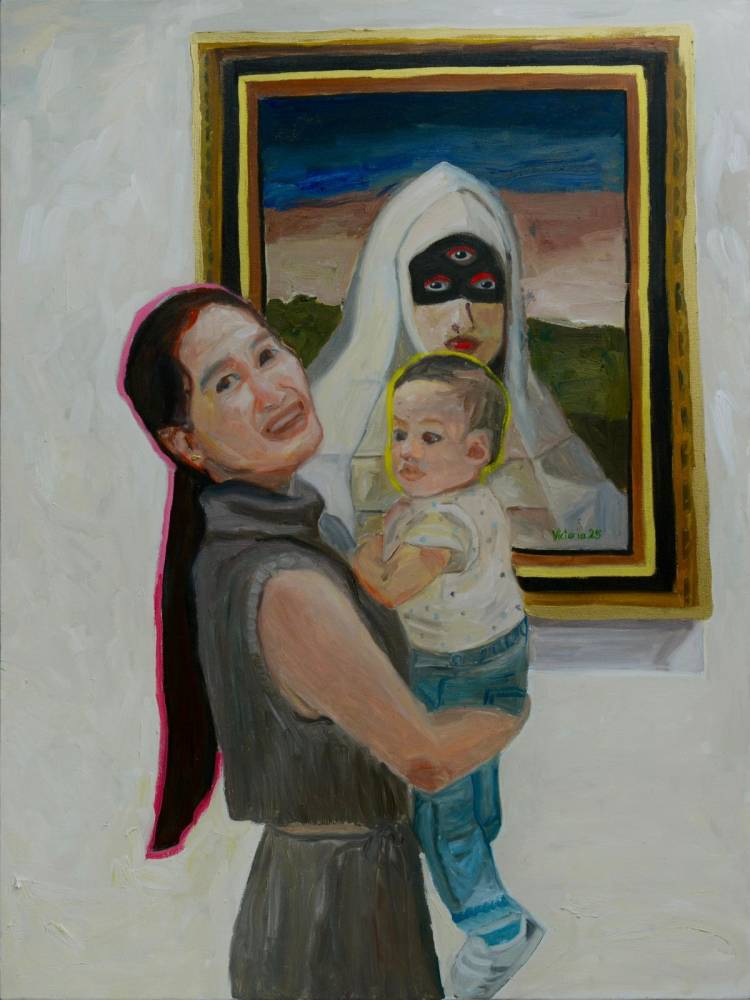
New myths of redemption
Jason’s new works maintain the dense, mythic visual worlds he’s long been known for. The artist continues to build a cosmology where characters are vessels, embodying ideas on morality, temptation, and ultimately spiritual restoration.
He introduces a new character with “Parlance,” depicting both an older and younger version portrayed in the show. Regal-looking with white hair in a mohawk, Jason describes him as a “Complex character… Hindi mo alam if masama or mabuti. Speaker siya, immortal. Parang speaker of the house. Pero ang problema ay hindi siya nagsasalita, lumalabas sa katawan niya.” As a mute shapeshifter, Parlance’s messages are delivered to leaders in a fictional society, sort of as a guide. But instead of speaking, his words appear through his shapeshifting body. “‘Yong itsura ’yon ‘yong message niya,” he expounds.
If “Parlance” shows the ambiguity of power, “Beauty for Ashes” proposes the possibility of redemption. The two-by-three-foot piece spells out the words “redundo,” “temporal,” and “lacuna” on a scroll. “Redundo” refers to the overflow of grace from God (“kahit masamang tao puwede magbago,” Jason explains), “temporal” signifies sin and carnality of the body, while “lacuna” is the void, the empty cavity, and the blankness.
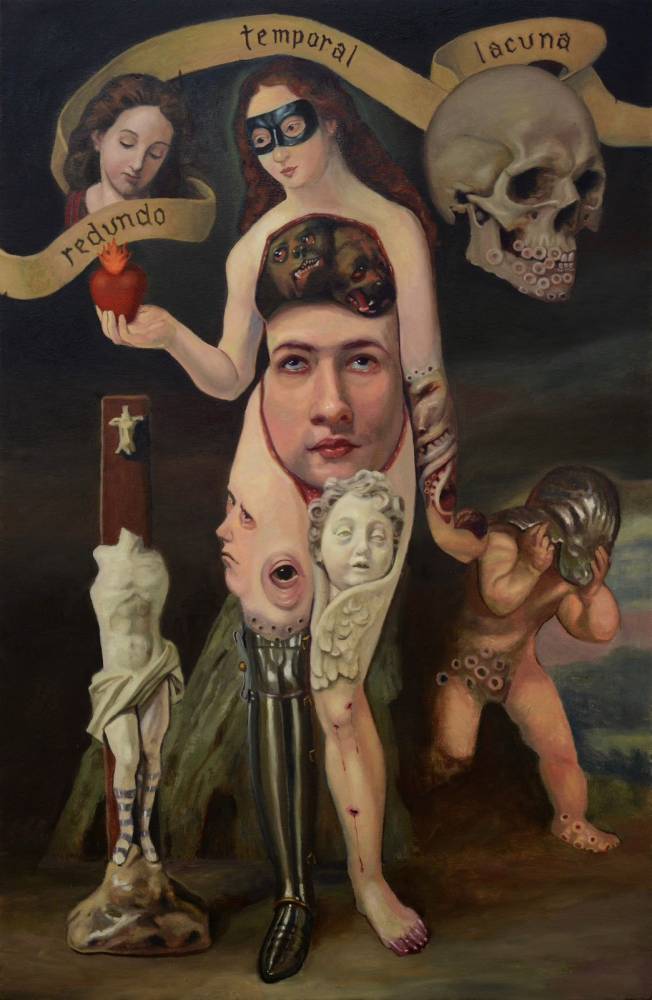
While the painting is laden with striking imagery, at its center is a masked lady, the nudity of her torso replaced by various faces within her body. She holds a sacred heart of fire, holding the heart much like Eve handing Adam an apple. Jason connects the work to the Hillsong song of the same name, “Beauty for Ashes,” as well as to Ephesians 6, “The Armor of God.” “‘Yong helmet ay salvation to cover your head so hindi ka magkakamali kasi alam mo ‘yong identity mo… Alam mo kung [ano] ‘yong pinoprotektahan mo, at unti-unti, bumubuo ’yong sarili mo ng armor.”
While allegorical, art critic Lec Cruz writes in the exhibition notes for Jason’s work that “Montinola’s work is not just a mere metaphorical illustration but a call to action—to reclaim a corrupted self, to restore it, and to make it whole again.”
The tender roots of home
While Jason’s imagery evokes battles of the spirit on a higher plane, Victoria’s painting grounds to life in the most intimate scale: at home.
“My work explores the role of the visual artist as a mother, and how her position as a homemaker shapes her perception of the world through the longings of motherhood,” she says.
In these new paintings, her works feel noticeably brighter than her past work. She maintains her practice of painting backgrounds of otherworldly forest scenes. But now, Victoria replaces her sharp geometry and darker figures with brighter, more playful forms that even seem friendly.
“What Grows in My Garden” features her signature style, now with tomato red roots, a striped figure, and a vibrant bush-like form. She likens the playful forms to her own life with Jason and their young son Miguel, recalling picnics and exploring the great outdoors together as a family.
“Pinakamahirap na decision kung sino ‘yong asawa mo at saan ka titira… I’m always with Miguel and always with Jason. Lagi kaming magkasama, kaming tatlo,” she says with a smile. “It’s not about structure (of the home); it’s about who you’re with, the memories we build with each other.”
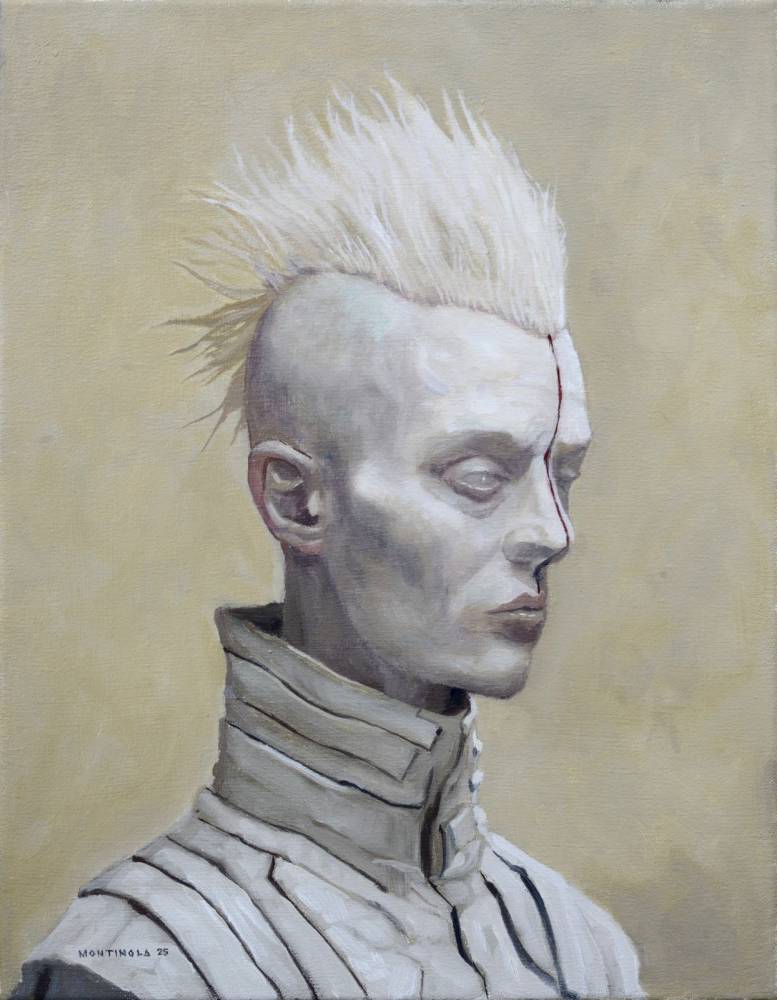
Another work features water lilies, inspired by Monet’s masterpieces they saw together as a family in the Nakanoshima Museum of Art in Osaka. Inspired by the impressionists’ distinct paintings of ponds, Victoria too leans into lightness.
She paints a slightly abstracted still life of wines. She recounts how she and her husband always receive wines as gifts, but that the two of them don’t drink. Instead, they use these fine wines to cook, which she paints in vibrant forms. Nearby are still lifes of loosely painted flowers.
And of course, going full circle, Victoria paints her family. She does a solo portrait of Jason, painting him with his unmistakable beard and newsboy cap, a textured brick wall behind him. In “Mother and Child,” she does a self-portrait holding their young son Miguel. Standing in front of a painting by Jason, a rendition of his other character “Here Lies the Painter,” she says how there are representations of the three of them, in effect creating a complete family portrait.
With cheerful palettes and organic forms that stretch toward play, there is a strong sense of tenderness in Victoria’s latest show, as her paintings examine home not as architecture but as presence.

A shared universe
Seen together, Jason and Victoria’s work feels like two halves of a single cosmology. One wrestles with spiritual rupture and restoration, the other traces the nuances of family and home.
The effect of “Home” is a visual diary, showing the Montinolas’ household in motion, while carrying the characteristics of myth in “Temporal” display a deep sense of reflection, upholding upright values with respect for the sacred.
Perhaps both overlap with each other, as his characters carry messages through shapeshifting characters, and hers carry memories of a life lived attentively, lovingly, and close together.
Both, in their own ways, are portraits of devotion.
Jason Montinola’s “Temporal” and Victoria Montinola’s “Home” run from Nov. 6 to Dec. 6 at West Gallery, 1104 West Ave, Quezon City










